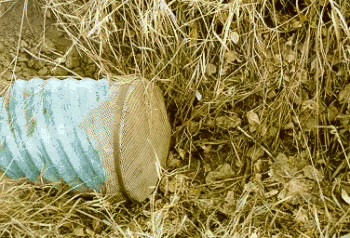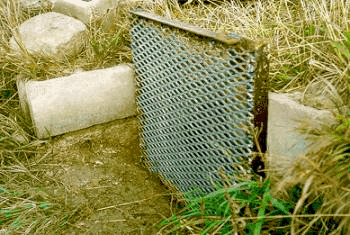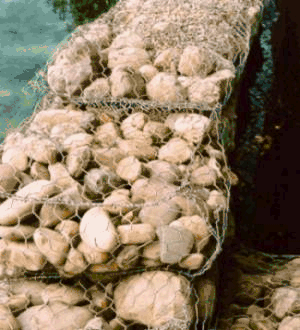| | Introduction | Screening device | Culvert-type screen | Farm ditch screen | Rock screen (Gabion filter)
Introduction
If your fish-rearing pond is constructed to allow the passage of water in and out of the impoundment, you need a permanent barrier restricting fish movement. Water passage could be from continuous flows, such as wells, aquifers and springs, or intermittent flows, such as annual runoff or flooding conditions.
Screening Device
The barrier or screening device must be securely constructed and assembled with quality materials before it will pass inspection. The primary concerns are to prevent fish from escaping and to eliminate potential environmental conflicts with wild fish stocks. Screen installation will also reduce the licencee's economic losses from fish escaping and the establishment of unwanted coarse or predator fish.
Various screening devices can be used, and these are constructed in differing sizes, shapes and from differing materials. Materials such as chicken wire or plastic mesh are not suitable, as they are difficult to clean, easily damaged and unable to withstand winter conditions.
Culvert-type Screen
The screen shown in Figure. 1 is simple to build, yet inexpensive and very effective. It has been successfully used on Alberta Agriculture and Rural Development research dugouts for many years. It can be built from new or scrap metal using a minimum of tools.

Figure 1. Culvert type screen installed on upstream end of Culvert .
Size of mesh is important as it needs to be smaller than the width of the fish, but at the same time, not too small to impede water flow. Mesh openings of 4.8 mm (3/16 inch) are considered the minimum for keeping in 50 mm (2 inch) fish. One square meter of this sized screen will handle water flows of 1700 liters/minute (1 cfs).
Use flattened, expanded metal mesh for the screening material. Do not confuse this material with standard expanded metal mesh, which has sharp, raised edges and is difficult to clean. Regular cleaning of screening devices is essential if they are to perform as designed.
When installing screening materials, first measure the diameter of the pipe the screen will be installed on. Consider using a minimum 30 cm pipe (12 inch) made of steel or polyethelyne.
Cut the screen 20 cm (8 inches) larger than the pipe diameter. Remove a V-wedge from the screen perimeter every 4 inches. This removal allows the screen to bend back and mold over the culvert. Secure the screen to the pipe with a metal clamp or coupling band. The bolts should be galvanized to stop corrosion.
For ease of cleaning, always place the screen on the upstream end of the pipe.
Farm Ditch Screen
The farm ditch screen can be used for intermittent water flows such as farm ditches with flows of less than 3400 liters/minute (2 cfs).The screen needs to be securely fastened and of sufficient height to contain all waters capably (Figure 2). The recommendation is to use flattened, expanded metal mesh. All wood material should be pressure treated.

Figure 2. Farm ditch screen bolted to concrete structure.
Rock Screen (gabion filter)
The rock screen is a very simple yet practical method to screen your pond. Rock and crushed gravel act as barriers to fish movement as the water filters through the gravel/rock screen. This system is effective for very slow water movement. However, water cannot be allowed to flow over the barrier's surface, since fish could escape or enter (Figure 3). Encase all rock in wire mesh or chain link. This technique will contain rocks and prevent erosion. It also allows you to chose a smaller rock diameter for fill. As a general rule, use varying sized rocks, from 100 to 200 mm in diameter (4 to 8 inches).
The gabion should be at least 2 meters wide, 3 meters long and above your highest water level. If flow is greater than 1700 liters/minute (1 cfs) or water is flowing over rocks, then a ditch screen or culvert screen will be necessary.

Figure 3. Rock screen.
Screen Openings For Trout*
| Fish Length | Fish Weight | Required Screen Spacing |
| mm | inches | grams | ounces | mm | inches |
| 51 | 2 | 1.5 | .05 | 5 | 3/16 |
| 76 | 3 | 5 | .17 | 10 | 3/8 |
| 127 | 5 | 28 | 1 | 13 | 1/2 |
| 203 | 8 | 114 | 4 | 19 | 3/4 |
| 305 | 12 | 284 | 10 | 25 | 1 |
| 381 | 15 | 681 | 24 | 35 | 1 3/8 |
*Trout larger than the above sizes will be confined using screen with the corresponding spacing. When using expanded metal mesh, check the widest opening (inside measurement) prior to purchase. Expanded metal mesh is diamond-shaped, and openings may be larger than advertised. Use of this chart for fish species other than trout is not appropriate, since many fish are shaped differently. More information may be obtained from Alberta Agriculture and Rural Development, Aquaculture Section.
Source: Agdex 485/87-1. April 1999. |
|